暗红刺蛇尾
Ophiothrix purpurea is a snake star in the Ophiotrichidae family.
The scientific name of the species was published in 1867 by Carl Eduard von Martens.
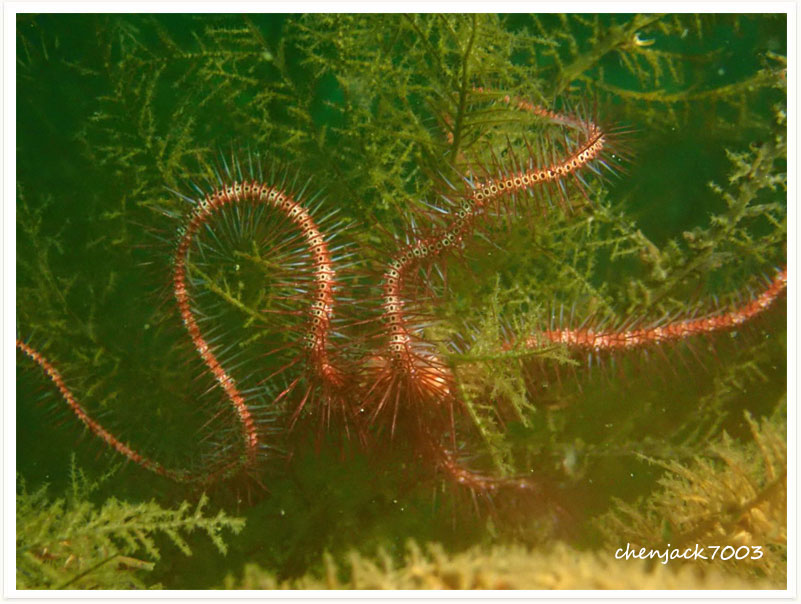
 Underwater Photography
Underwater PhotographyOphiothrix purpurea is a snake star in the Ophiotrichidae family.
The scientific name of the species was published in 1867 by Carl Eduard von Martens.

Naticarius orientalis is a species of predatory sea snail, a marine gastropod mollusk in the family Naticidae, the moon snails.
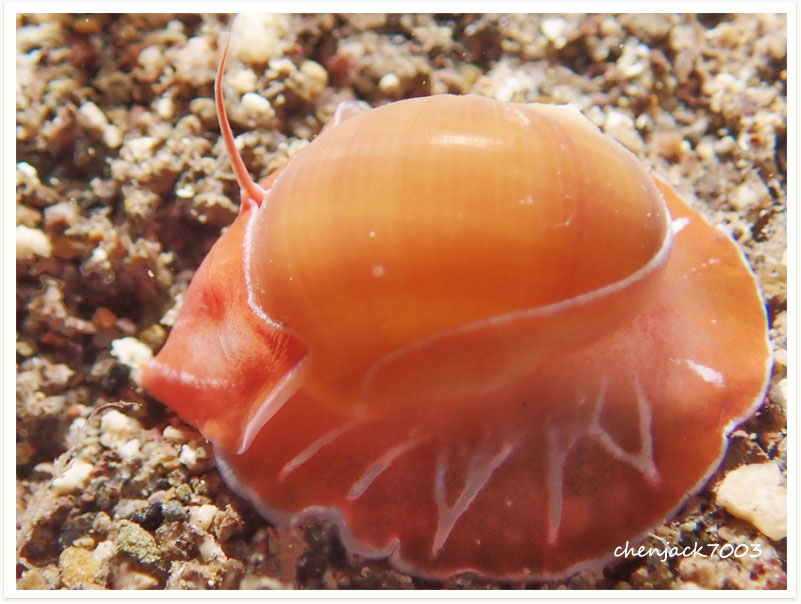
Commensal star fish shrimp
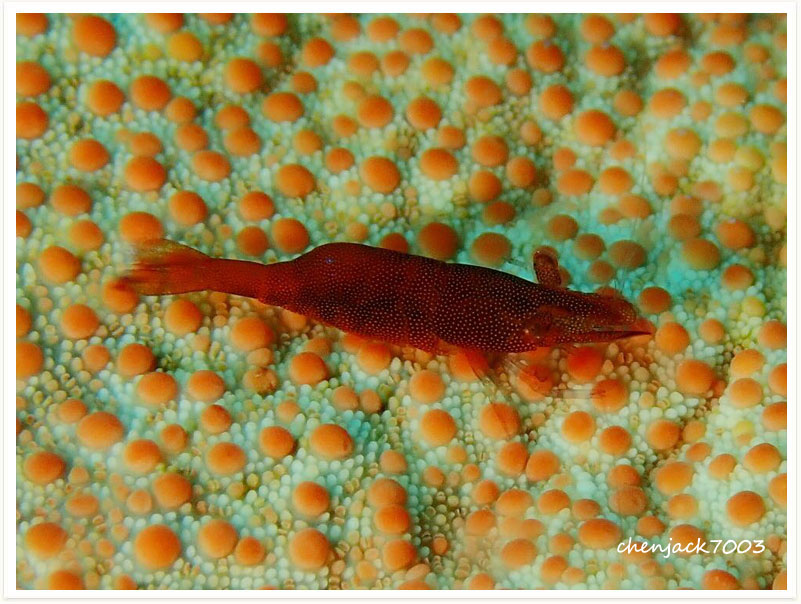
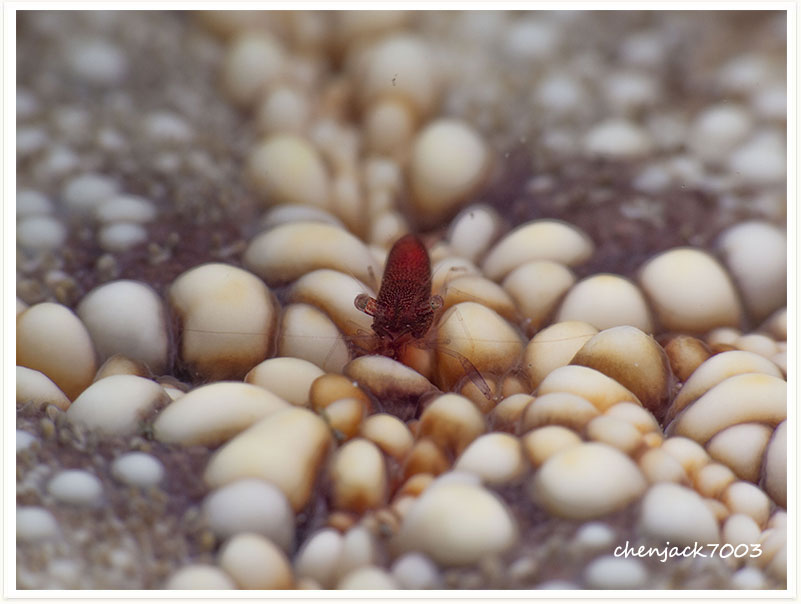
Trachypenaeopsis richtersii is a ten-legged species of the Penaeidae family. The scientific name of the species was first validly published in 1884 by Miers.
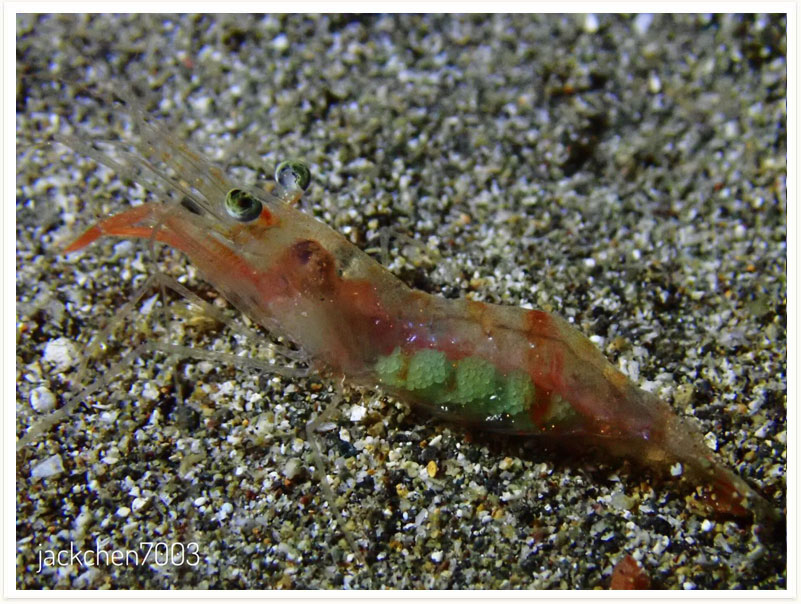
Stenopus hispidus reaches a total length of 60 millimetres (2.4 in), and has striking colouration. The ground colour is transparent, but the carapace, abdomen and the large third pereiopod are all banded red and white.The antennae and other pereiopods are white. The abdomen, carapace and third pereiopods are covered in spines.
The Processidae are a family of shrimp, comprising 65 species in five genera, and the only family in the superfamily Processoidea. They are small, nocturnal animals, mostly living in shallow seas, particularly on grass flats. The first pereiopods are usually asymmetrical, with a claw on one, but not the other (Ambidexter forming the exception to this rule). The rostrum is generally a simple projection from the front of the carapace, with two teeth, one at the tip, and one further back
Phycocaris simulans is a shrimp species from the Hippolytidae family. The scientific name of the species was first validly published in 1916 by Kemp.
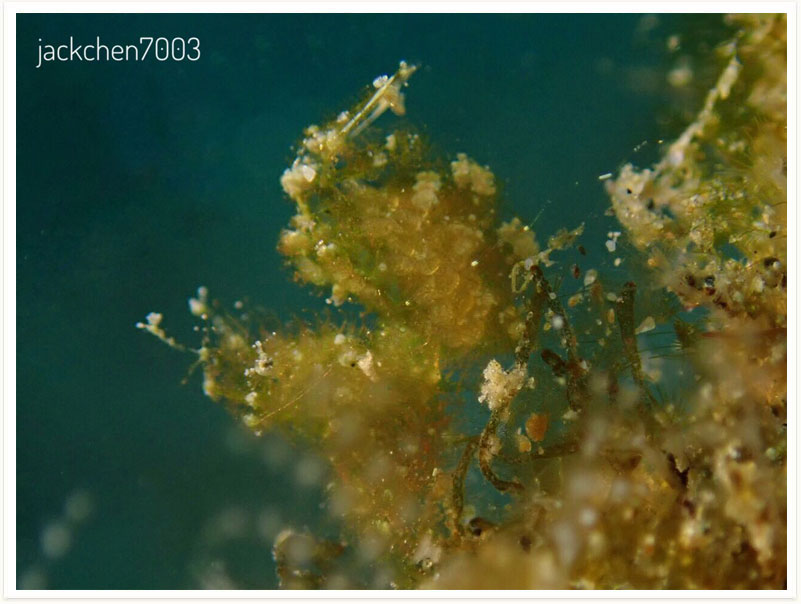
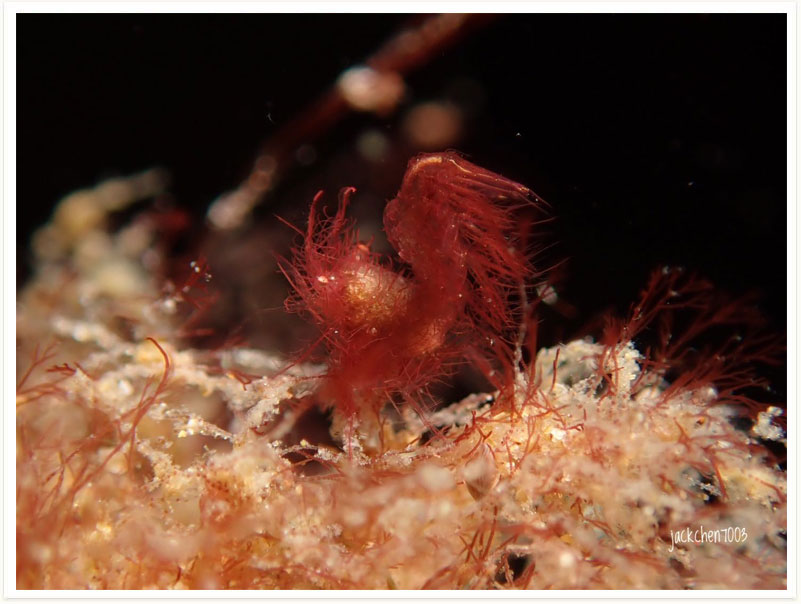

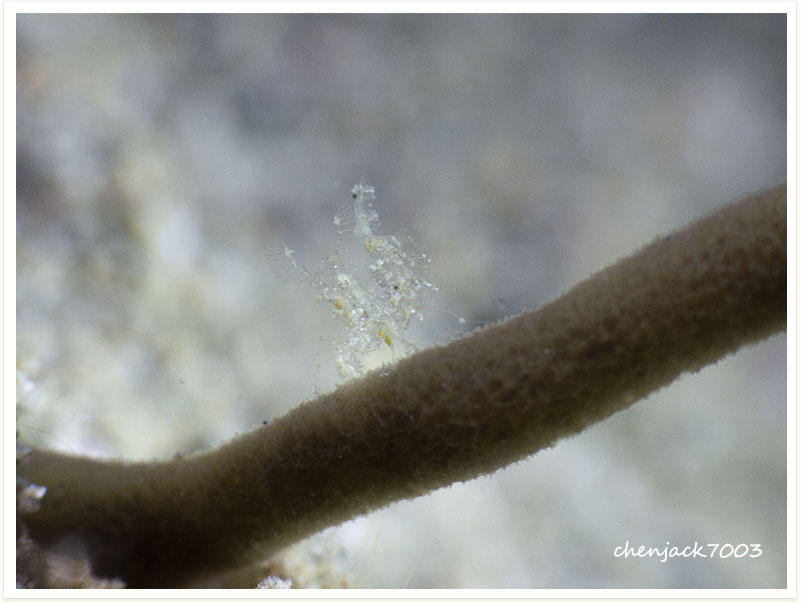
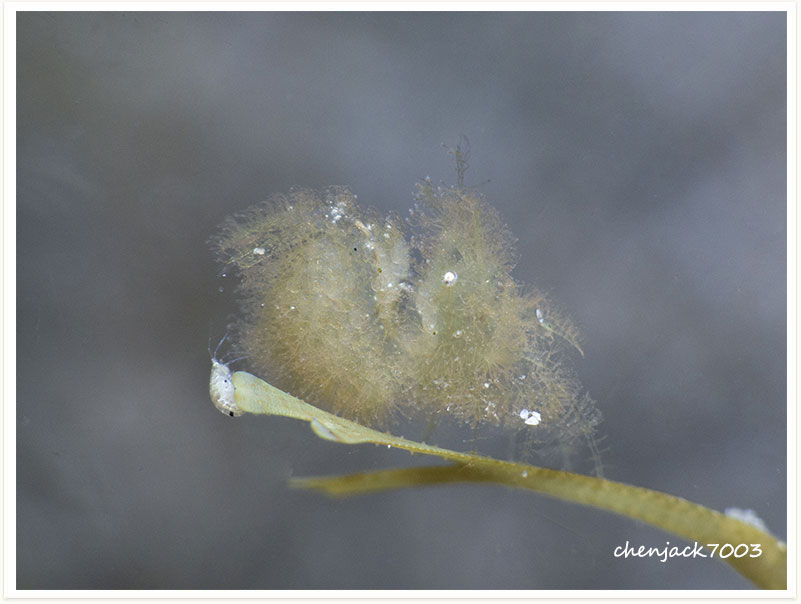
Lysiosquillina lisa is a praying mantis of the Lysiosquillidae family. The scientific name of the species was first validly published in 2001 by Ahyong & Randall.

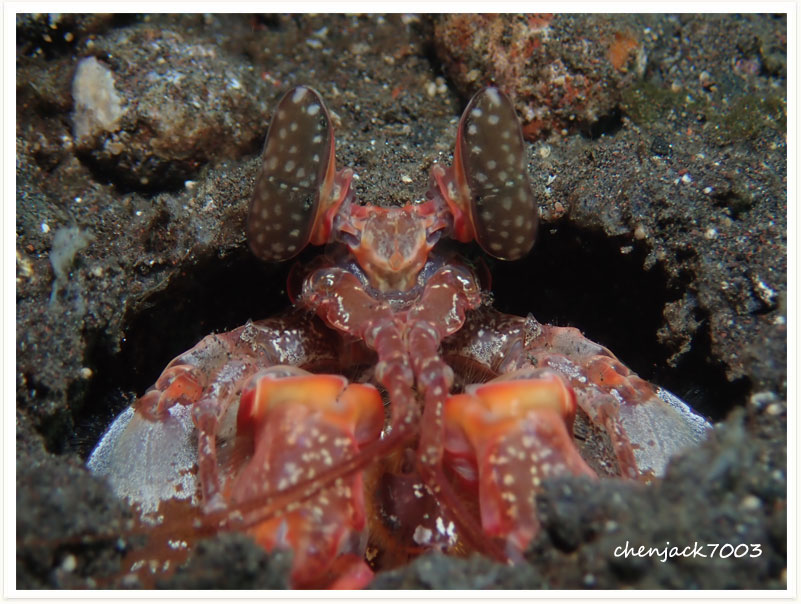
Idiomysis is a genus of small mysids found in warm, shallow waters of Indian Ocean (including Red Sea) and Pacific.
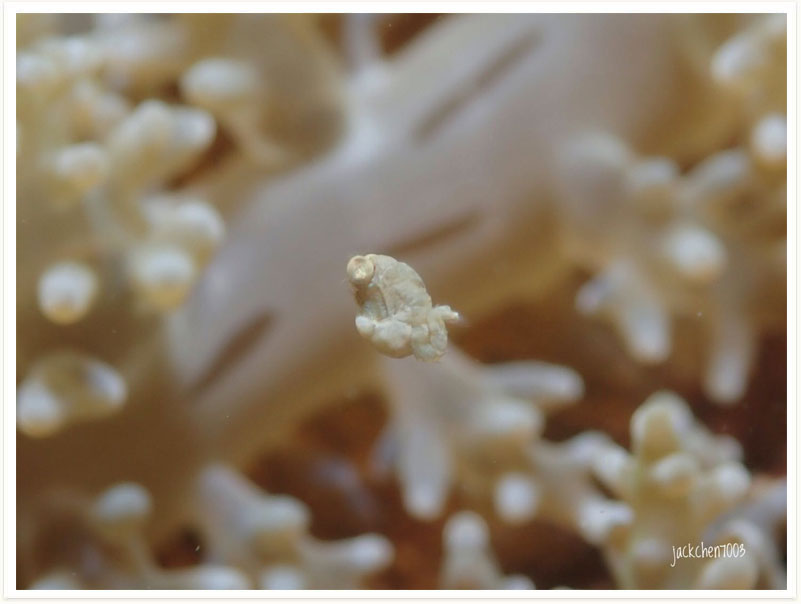
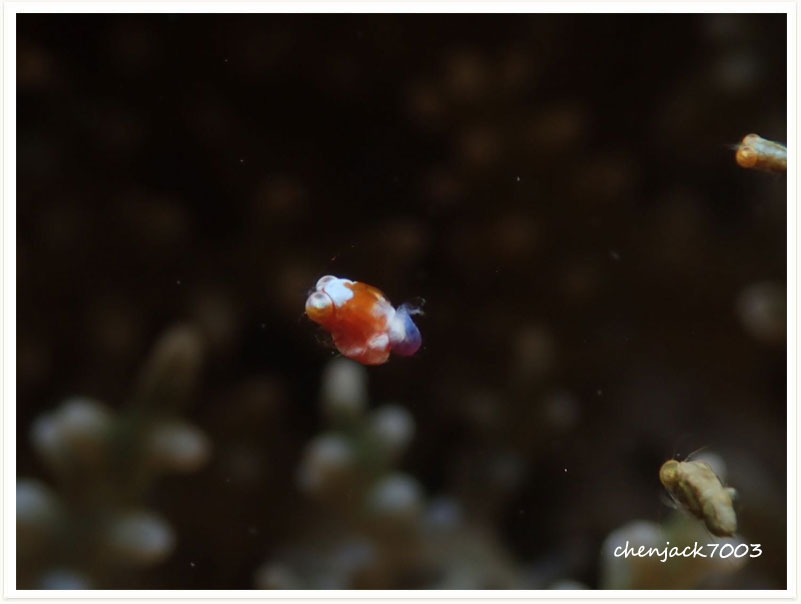
Also known as Anemone Shrimp, Carid Shrimps, Commensal Shrimps, Crown Shrimp, Ghost Shrimp, Heliofungia Shrimp, Mushroom Coral Shrimp, Partner Shrimp, Plate Coral Shrimp, Plumed Shrimp, Popcorn Anemone Shrimp.
Found on coral and rocky reefs living in a symbiotic relationship with various anemones and mushroom corals. They feed on algae, parasites and plankton. Body transparent, red to black with a white spiny head (that looks like a dollop of cream) Length 4cm Depth – 3-30m Widespread Western Central Pacific
Flower urchins are relatively large sea urchins. They can reach a maximum diameter of around 15 to 20 cm (6 to 8 in). Like most echinoderms, the body of adult flower urchins is equally divided into identical segments around a central axis in multiples of five (pentaradial symmetry). The rigid “shell” (test) has five interambulacral segments separated from each other by five ambulacral segments, each of them are composed of smaller regularly interlocking plates. It is overlaid by a thin layer of skin in living individuals. The test is variegated in coloration, usually deep red and grey, though there are rare instances of green and pale purple.Each ambulacral segment is ornamented by a large purple zigzag pattern running along its length.
Eucidaris thouarsii, the slate pencil urchin, is a species of cidaroid sea urchins that inhabits littoral regions of the East Pacific Ocean.
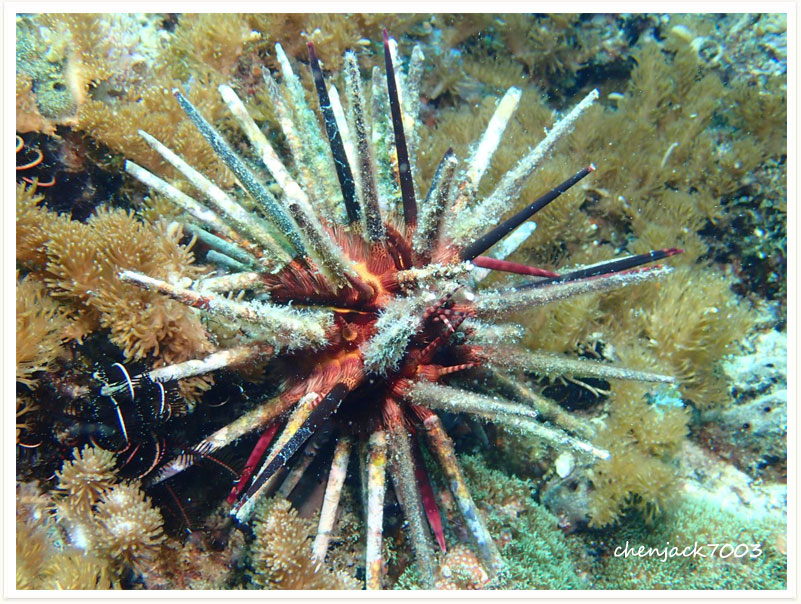
The Banded sea urchin has a slightly oval test (shell), reaching a diameter of about 5 cm. Like almost all the Diadematidae (but it is in Echinothrix calamaris that it is most obvious) it has two different sets of spines, shorter and slender closed spines which are going from yellow to dark (through brown) in colour and can deliver a nasty sting, and longer and thicker spines that are often banded with light and dark colour (but sometimes all dark or all white), and reaching 10 to 15 cm in length. These radiolas can be blunt, and are hollow. The spines are grouped so as to let appear five naked zones on the central part of the test, in a star pattern (called “iridophores”): this pattern can be colored, often in blue. The anal papilla is big, more or less translucent and very obvious on the aborale face; it is generally whitish and speckled with black and white dots, circled by a ring of visual receptors that grant it a rudimentary vision.
Ctenoides ales is a species of saltwater clam, a marine bivalve mollusk in the family Limidae, the file clams. It is known by the names electric flame scallop, disco scallop, electric clam and disco clam. The clam has been given these nicknames because its soft tissues flash light like a disco ball. Along with Ctenoides scaber, they are among the only bivalves known to have light displays.
Holothuria edulis is a medium-sized sea cucumber reaching a length of about 30 centimetres (12 in). It has a roughly cylindrical shape with rounded ends but can retract and expand its body and adopt different shapes. It is usually soft and pliable with a smooth skin but, due to the special characteristics of its connective tissue, it can become firm and rigid. The body is lined with longitudinal rows of small tube feet which can be withdrawn into the body wall, leaving small hollows. About twenty tube feet in a ring round the mouth are modified into feeding tentacles. This sea cucumber is usually a dark reddish-black colour on its upper side and a pinkish-mauve colour below, but can be grey or dark brown.
This relatively large pleurobranch is often found in quite large populations in shallow lagoons, reef crests and pools and sea grass beds. It usually grows to about 10cm long but can grow to over 30cm. This species feed on ascidians.
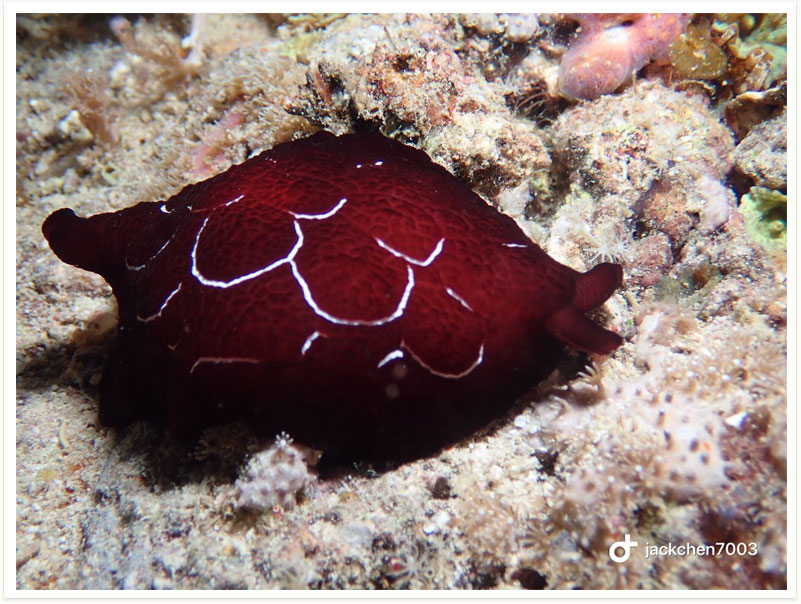
This brown white nudibranch feeds on sponges genus Euryspongia.The mantle margin,rhiniphores and gills are orange-brown in colour.
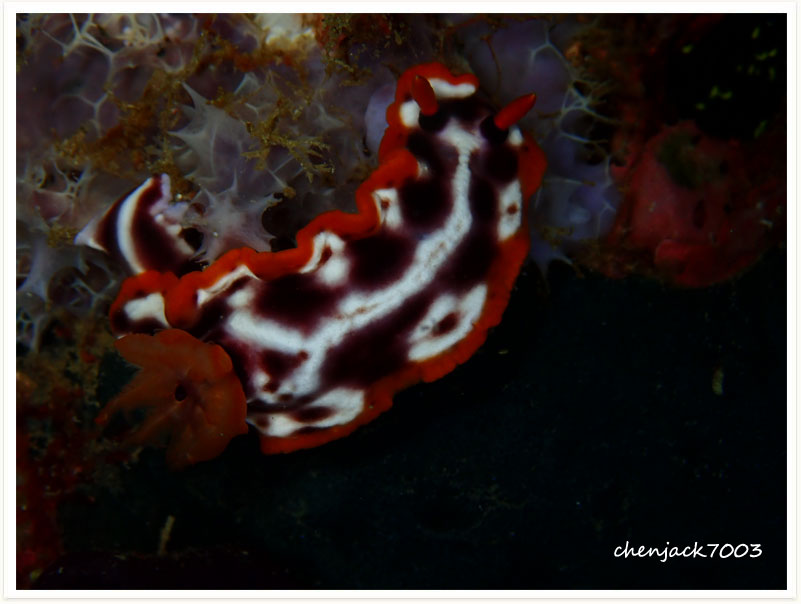
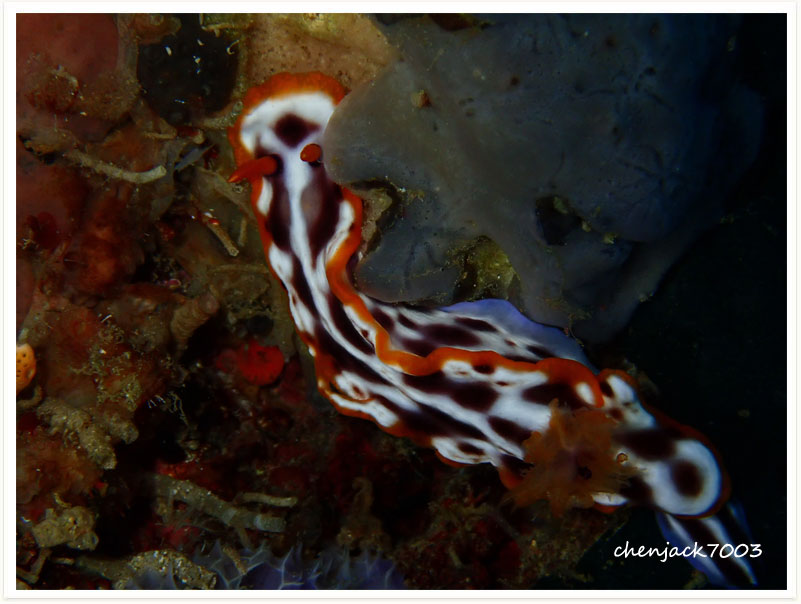
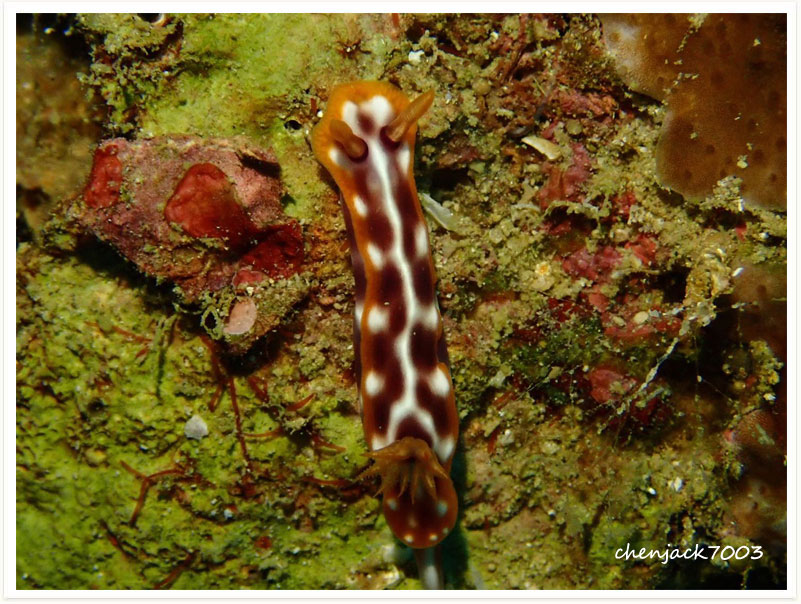
The Spanish dancer is a large dorid nudibranch which can grow up to a maximum length of 90 cm. However, the commonly observed size is between 20 and 30 cm long. Its body coloration is generally orange-red speckled with multiple small white dots but it also can be uniformly bright red or yellow with red scattered spots. Its body is soft and flattened, the anterior dorsal portion has a pair of retractable rhinophores and the posterior part has six contractile gills inserted independently in the body. The pair of oral tentacles are constituted by a fin flexible membrane provided with large digital lobes.
This species feeds exclusively on sponges.
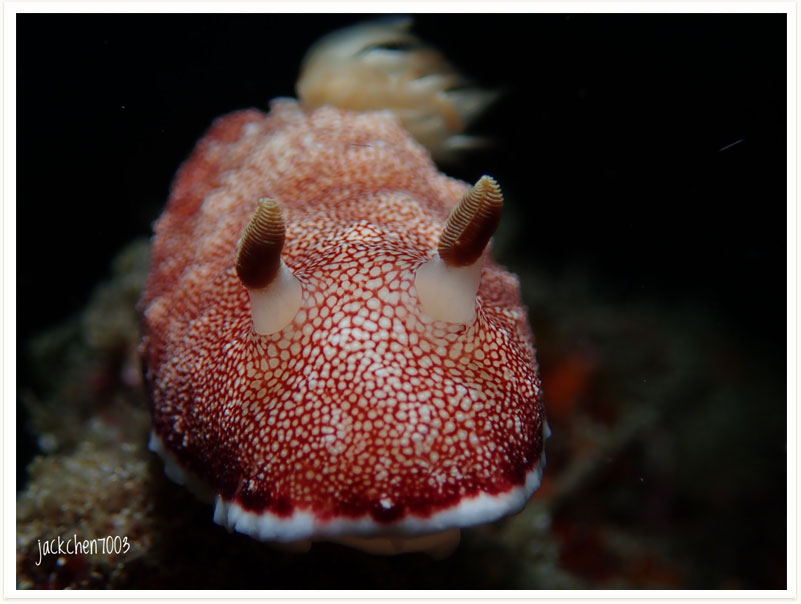
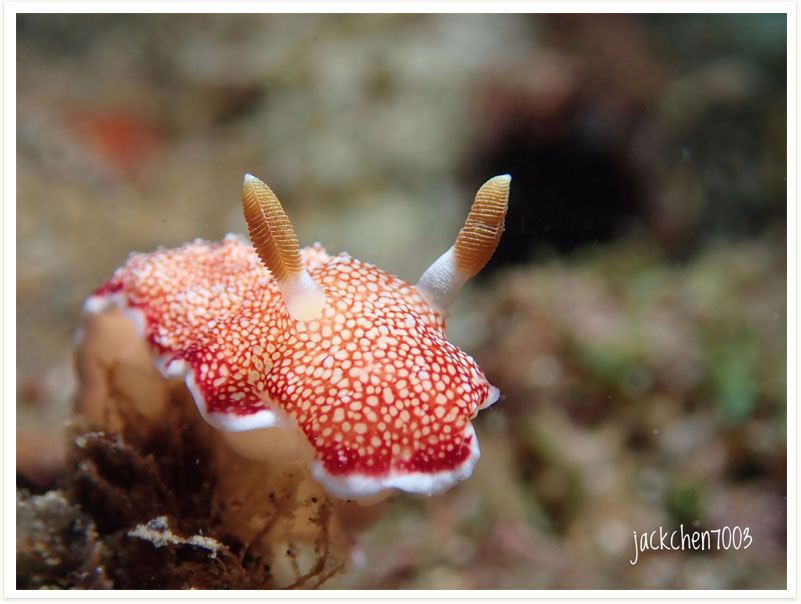
Lives under corals in embayments, which are sometimes covered by siltation. Also found in caves and crevices of sheltered reefs. It often positions itself upside-down on the roof of the recess
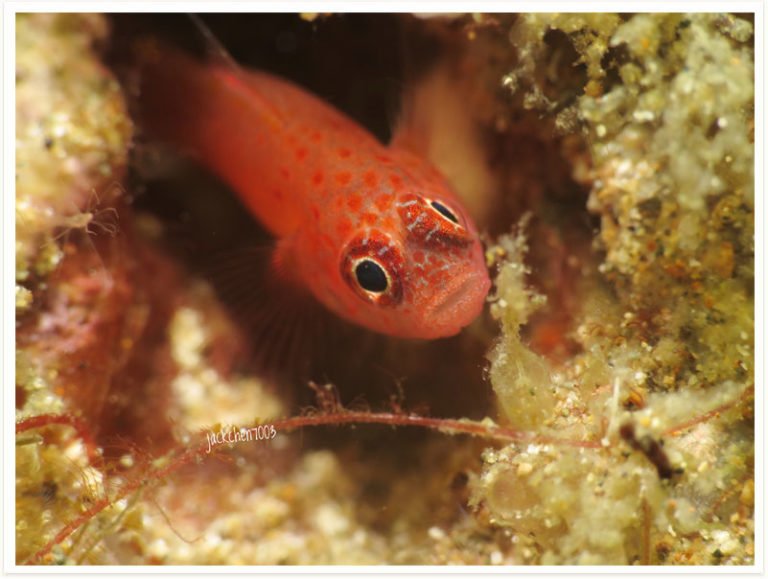
Living in waters 4 to 91 meters, occasionally juvenile seaweed in the tide pools or prosperous region, to fish habitat in the sand on the reef or reef flats mixing zone. Swimming ability is not strong, often perched on the reef, opportunistic predator. Carnivorous, to fish and small benthic invertebrates based. Breeding season is from May to October, buoyant eggs hatch after about 17 hours
The ornate ghost pipefish or harlequin ghost pipefish, Solenostomus paradoxus, is a false pipefish of the family Solenostomidae. The species name comes from the Greek paradoxos, referring to this fish’s unusual external features. Ornate ghost pipefish are found in the Western Pacific and the Indian Ocean along reef edges prone to strong currents from the Red Sea to Tonga. They reach a maximum length of 12 cm. They vary in color from red or yellow to black and are almost transparent. Although relatively common, ornate ghost pipefish are very well-camouflaged and difficult to find. It occurs either as solitary individuals or in pairs, among the branches of gorgonians, in floating weeds, or crinoids where the feed on mysids and small benthic shrimp.
The tasseled scorpionfish, or small-scaled scorpionfish, Scorpaenopsis oxycephala, is a carnivorous ray-finned fish with venomous spines that lives in the Indian and Pacific Oceans. It can reach a maximum length of 36 cm (14 in) and can vary considerably in color. Adults are bearded with a number of tassels below the jaw.
The false stonefish has a broad head with a wide mouth, a humped back, and a tapering body, and can reach 30 cm (12 in) in length. Its dorsal fin has 12 venomous spines and eight to 10 soft rays. The anal fin has three spines and five to six soft rays. The skin is rough with low conical projections, spines, and tassels. The colouring is a combination of mottled grey and white with reddish-brown blotches and the fish is well-camouflaged among stones and corals. The inner sides of the broad pectoral fins have orange, black, and white blotches and the fins can be “flashed” as a warning. This fish closely resembles the reef stonefish (Synanceia verrucosa).
Scarus tricolor is a greenish parrotfish which normally shows pinkish or yellowish tints on the posterior portion of its body and a purplish band just inside the margin of each lobe of the caudal fin. The females are dark grey to almost black shading to blue to bluish-green on the lower flanks, with black edging to the scales, a red tail fin, an orange anal fin and sooty yellowish to orange pelvic fins. The terminal phase males are similar to those of Scarus forsteni, the most notable difference being that S. tricolor has a yellow inner pectoral axil.
Sargocentron spiniferum is the largest squirrelfish in its range and can reach up to 51 cm (20 in) in length and 2.6 kg (5.7 lb) in weight (the Atlantic Holocentrus adscensionis can surpass the length, but it is slimmer). A more common length for S. spiniferum is 35 cm (14 in). The body is oval and laterally compressed. The head has a pointed snout and large eyes, being largely nocturnal. The basic colour is bright red. It has silver scale margins, a spinous dorsal fin and a large deep red patch just behind the eyes. The lower jaw protrudes beyond the upper jaw. It bears a very long preopercle spine (near the gill-opening). The anal and ventral fins are yellowish. The caudal fin is clearly bifid.
The red lionfish (Pterois volitans) is a venomouscoral reef fish in the familyScorpaenidae, orderScorpaeniformes. P. volitans is native to the Indo-Pacific region, but has become an invasive species in the Caribbean Sea, as well as along the East Coast of the United States and East Mediterranean. This and a similar species, Pterois miles, have both been deemed invasive species. Red lionfish are clad in white stripes alternated with red/maroon/brown stripes. Adults in this species can grow as large as 47 cm (18.5 in) in length, making it one of the largest species of lionfish in the ocean, while juveniles are typically shorter than 1 inch (2.5 cm). The average red lionfish lives around 10 years. As with many species within the family Scopaenidae, it has large, venomous spines that protrude from the body, similar to a mane, giving it the common name lionfish. The venomous spines make the fish inedible or deter most potential predators. Lionfish reproduce monthly and are able to quickly disperse during their larval stage for expansion of their invasive region. No definitive predators of the lionfish are known, and many organizations are promoting the harvest and consumption of lionfish in efforts to prevent further increases in the already high population densities.
Parupeneus barberinoides, the bicolor goatfish, is a species of goatfish native to the western Pacific Ocean. An inhabitant of coral reefs, it can be found at depths of from 1 to 40 metres (3.3 to 131.2 ft). This species can reach a length of 30 centimetres (12 in) TL though most are only around 20 centimetres (7.9 in). This is a commercially important species and can also be found in the aquarium trade.
Living as it does on coral reefs, and hunting by day, O. cyanea is adept at camouflage and not only can change colour frequently, but also can change the patterns on and texture of its skin. One researcher observed it change its appearance 1000 times in seven hours. As it moves across the seabed it makes changes in its colouring and appearance to match the substrate beneath.[6] The colour changes are instantaneous and made by chromatophores under direct control of the brain. This octopus sometimes produces a “passing clouds” display when stationary near prey such as a crab; this mimics a dark shadow passing across its surface and may encourage the crab to move incautiously.
Nemateleotris magnifica, the fire goby, fire fish, fire dartfish, or red fire goby is a species of dartfish native to the Indian and Pacific oceans from the eastern coast of Africa to the Hawaiian Islands and from the Austral Islands north to the Ryukyu Islands. It is an inhabitant of reefs where it can be found at depths of from 6 to 70 metres (20 to 230 ft). It is usually found just above the bottom, facing into the current, where it awaits its prey of small invertebrates.
The zebra turkeyfish is an unusual looking fish with vertical stripes in orange, white and black on the body, and large, banded fan-like pectoral fins that flare out on either side as the fish lies on the seabed. The front dorsal fin is made up of thirteen tall, quill-like spines and the second dorsal fin has ten to eleven soft rays. The anal fin has three spines and about ten soft rays. The second dorsal fin, the anal fin and the rounded caudal fin are transversely banded in black and white. This fish grows to a maximum length of about 25 cm (10 in).
This species can reach 40 cm (16 in) in total length, though most do not exceed 20 cm (7.9 in).As a juvenile, it is a bright red colour with large, black-margined white spots. As an adult, it has a pink face and fins, with the exception of the tail fin, which is bright yellow. The body is green towards the anterior darkening and decorated with bright blue specks towards the caudal peduncle. The fish also gains a very bright orange anterior when it grows into adulthood, and has a drastically shaded body in the posterior region that is dotted with very bright blue spots ringed with dark blue.
This is an unusual octopus species, active only at night. It can be found on sandy and rubble areas, areas with a seaweed cover or on rocky and coral reefs. It has a reddish brown colour and when agitated, white star-like spots appear all over its body which is its only possible colour change. It is poorly known and quite rare. It can be found on sand, seaweed and rubble and is only active at night. The common name comes from the numerous small white spots that are scattered over the body and arms. It is also very fast-moving.
Bulbonaricus brauni (Braun’s pughead pipefish) is a species of marine fish of the family Syngnathidae. It is found in the Eastern Indian Ocean, from Indonesia to Western Australia, and off the Ryukyu Islands of Japan. It lives among coral reefs at depths of 1-10m, and can grow to lengths of 5.5 cm. This species is ovoviviparous, with the males carrying eggs in a brood pouch until they hatch. The specific name honours “the collector” Mr J. Braun who brought the living holotype to the Western Australia Museum
It is a marine, tropical eel which is known from the Indo-Pacific. It dwells at a depth range of 1 to 35 m (3.3–114.8 ft), and inhabits burrows formed in sandy areas in rocky and coral reefs. During the night it often lets its head and neck protrude from its burrow, but during the day it only leaves its snout and some of its head exposed. It can reach a maximum total length of 101 cm (3 ft 4 in).
The warty frogfish grows up to 15 cm (5.9 in) long. Like other members of its family, it has a globulous, extensible body, and its soft skin is covered with small dermal spinules. The skin is covered with numerous small, wart-like protuberances. Its large prognathous mouth allows it to consume prey its same size. The coloring of its body is extremely variable because it tends to match its living environment.
A. melanopus adults can grow to 12 cm (4.7 inches). The body of A. melanopus is a dark red to orange with mahogany sides. Juveniles and adults have a white head band, which is wide and starts behind the eye, which may gave a blue tint. The dorsal and caudal fins of the fish have a lighter color than the rest of the fish and can sometimes be a cinnamon color. The pelvic and anal fins are usually black.
Thenus orientalis is a species of slipper lobster from the Indian and Pacific oceans.
T. orientalis is known by a number of common names. The United Nations’ Food and Agriculture Organization prefers the name flathead lobster, while the official Australian name is Bay lobster. In Australia, it is more widely known as the Moreton Bay bug after Moreton Bay, near Brisbane, Queensland. In Singapore, both the flathead lobster and true crayfish are called crayfish. They are used in many Singaporean dishes. The species is sometimes confused with the Balmain bug (Ibacus peronii) but it can be distinguished by the placement of the eyes: the eyes of I. peronii are near the midline, while those of T. orientalis are at the margin of the carapace.
Munida olivarae is a ten-pot species from the Munididae family. The scientific name of the species was first validly published in 1994 by Macpherson.

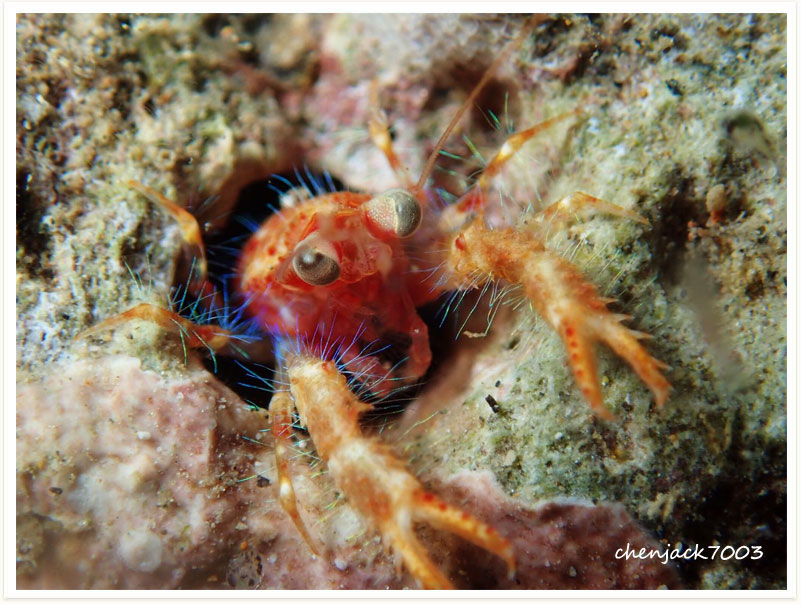 .jpg)
.jpg)
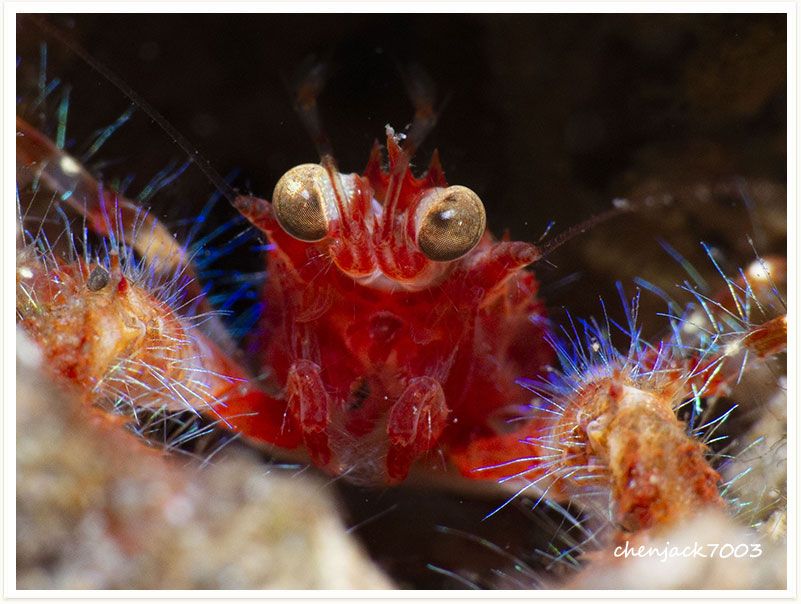
Trapezia cymodoce is a species of crab from the Trapeziidae family. The scientific name of the species was first validly published in 1801 by Herbst.
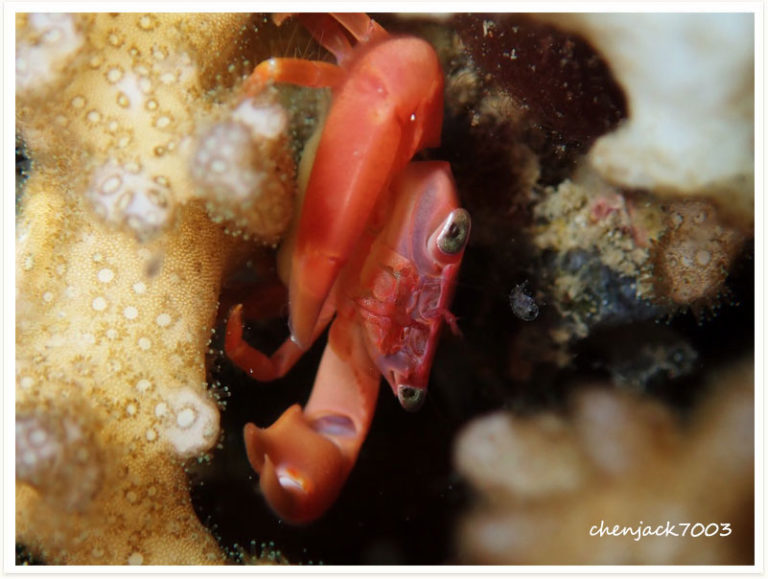
Quadrella maculosa is a species of crab from the Trapeziidae family. The scientific name of the species was first validly published in 1898 by Alcock.
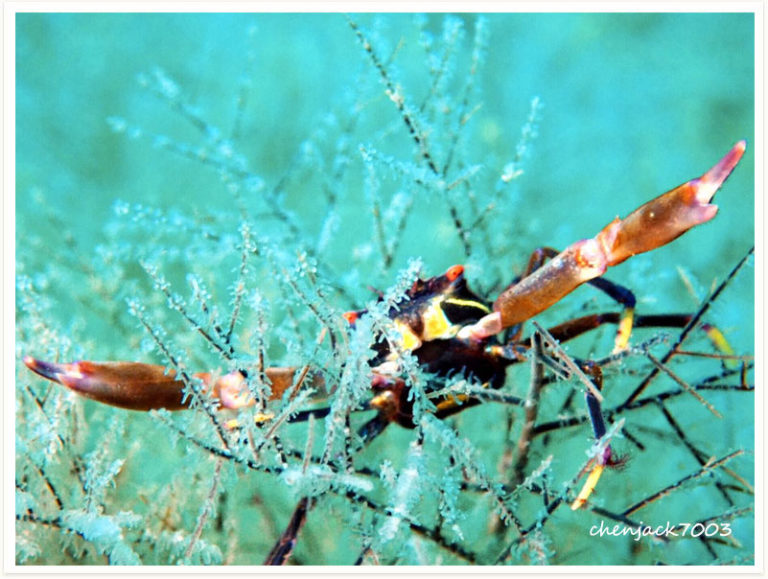
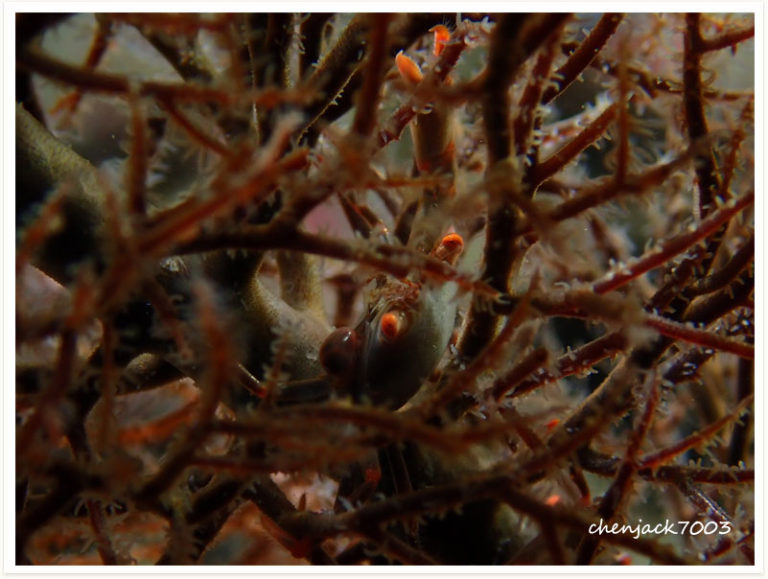
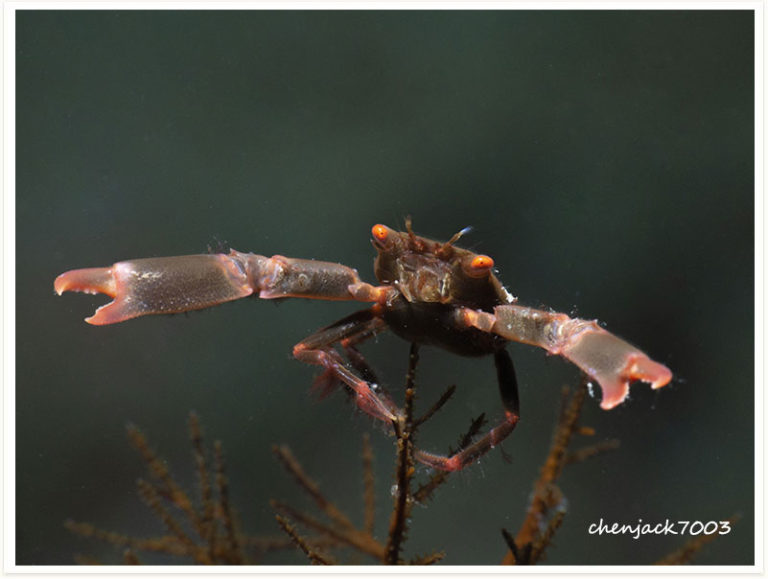
Neopetrolisthes maculatus is a species of porcelain crab from the Indo-Pacific region.It is a small, colourful crustacean with a porcelain-like shell. This porcelain crab is usually found within the stinging tentacles of a number of sea anemone species.
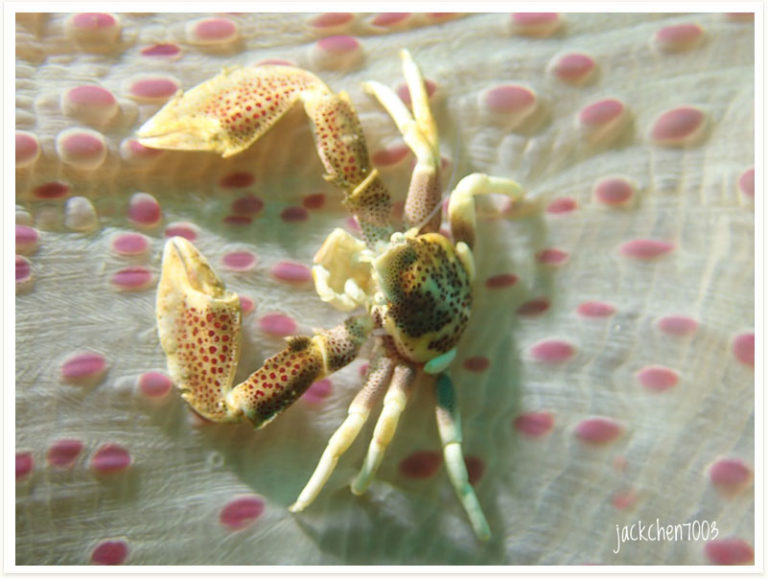
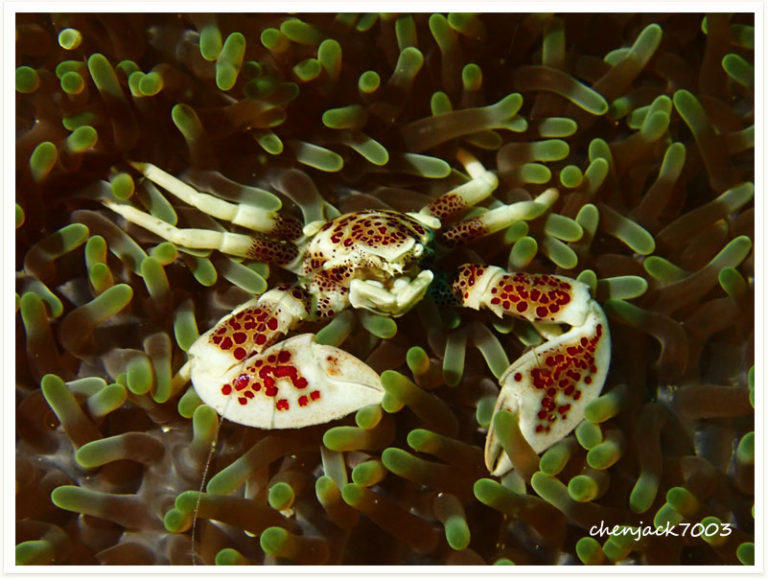
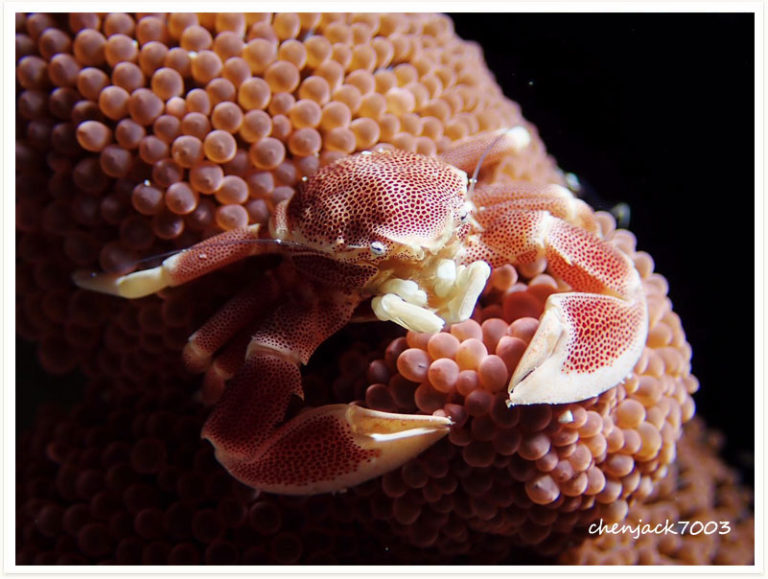
Lissocarcinus laevis is een krabbensoort uit de familie van de Portunidae. De wetenschappelijke naam van de soort is voor het eerst geldig gepubliceerd in 1886 door Miers.
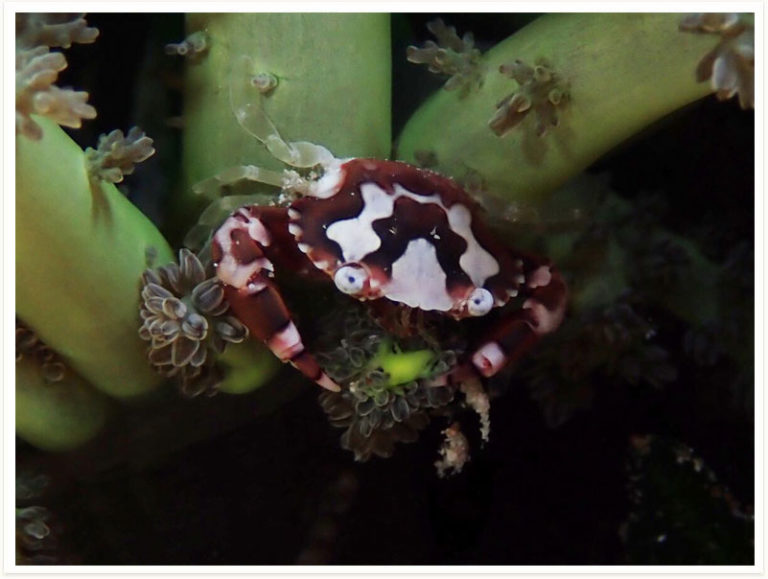
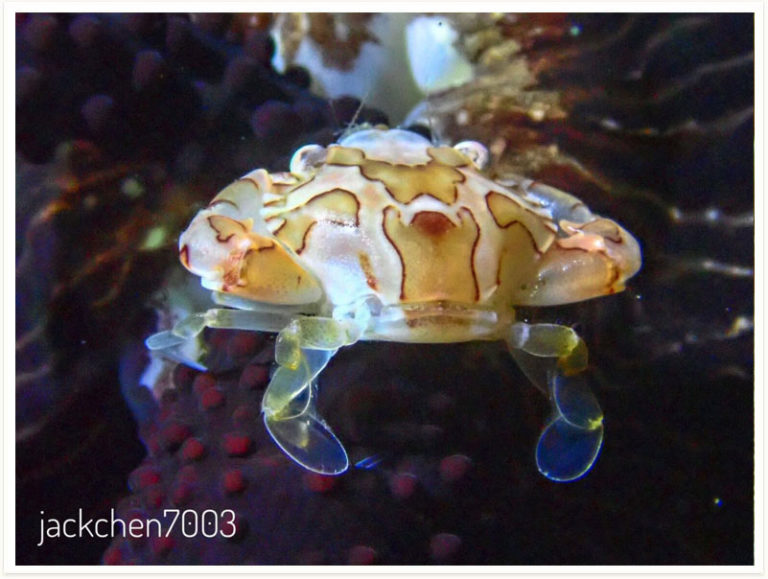
Achaeus japonicus, sometimes known as the orang-utan crab, is a crab of the family Inachidae (spider crabs or decorator crabs) which can be observed in tropical waters of the central Indo-Pacific.
With a carapace of only about 2 centimetres or 0.8 inches in diameter, it has relatively long arms, which are thickly covered with fine hairs, red or reddish brown in colour, and often laden with small bits of debris for further camouflage. It is frequently, but not always, found in association with the bubble coral Plerogyra sinuosa.